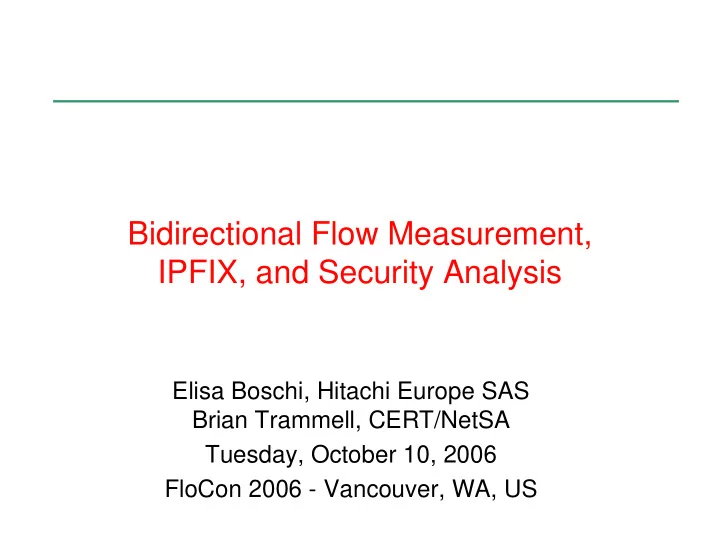

Bidirectional Flow Measurement, IPFIX, and Security Analysis Elisa Boschi, Hitachi Europe SAS Brian Trammell, CERT/NetSA Tuesday, October 10, 2006 FloCon 2006 - Vancouver, WA, US
Introduction and Motivation • Bidirectional flow (biflow) information useful for a variety of security-relevant use cases. – Aggregate response counting – Passive identification of open hosts/services • Biflow matching easier closer to measurement interface. – Biflow matching is O(n 2 ) , so making n smaller is worth the effort. • IPFIX is the emerging standard for flow export. • Therefore, we need an efficient way to represent biflow data using IPFIX. October 10, 2006 FloCon 2006 - Vancouver, WA 2 – Issue identified at FloCon 2005 in Pittsburgh.
Biflows Defined • Loosely: Association of information about both directions of a bidirectional communication. s r c(A ) ds t(B ) coun te r s / v a lues s r c(B ) ds t(A ) coun te r s / v a lues s r c(A ) ds t(B ) fwd coun ter s / va l ues r ev coun te r s / va l ues • Practically speaking: Choose one side of the communication to be the “source”, the other the “destination”, and maintain two sets of counters and other value fields (“forward” and “reverse”). October 10, 2006 FloCon 2006 - Vancouver, WA 3
Biflow Direction Assignment • By Initiator: “source” is source of packet initiating the communication (active open for TCP). – Approximated by assuming first packet seen is the first packet sent. – Can be validated through use of TCP flags, application protocol analysis (e.g. UDP DNS answer count), etc. • By Interface/Address: “source” and “destination” assigned via membership in address set or side of a given interface. – Useful when defining a perimeter: assign “source” October 10, 2006 FloCon 2006 - Vancouver, WA 4 “ tt k ”
Current Work in Biflows • QoSient Argus explicitly collects and exports biflows. • Any technique that needs to model the network state of end systems (e.g. IDS such as Snort, Bro) must use an internal biflow data model. • A few measurement research projects implicitly use a biflow model. – Most efforts are still trace-based, so no flow export or storage. • Most flow collection is uniflow-based. – Legacy of NetFlow and efficiency concerns on the router. October 10, 2006 FloCon 2006 - Vancouver, WA 5
Efficiency in Biflow Matching • Biflow matching is O(n 2 ) on number of concurrently matchable flows. • n particularly large on asymmetrically routed networks. – All traffic must be centralized and matched. – Overhead of biflow matching may outweigh benefits. • n manageable at symmetric routing points. – A “symmetric” routing point here need not be on the same line card or in the same router, if it’s in the same room. • n trivial on smaller networks measured at layer 2. October 10, 2006 FloCon 2006 - Vancouver, WA 6
IPFIX • Unidirectional, multi-transport, binary flow export protocol. – SCTP (+DTLS): preferred – TCP (+TLS): supported – UDP (+DTLS, over dedicated link): de facto • Uses templates to define record formats in terms of information elements. • Defines a message format and an information model from which information elements can be chosen. • Information model is extensible. – IANA registry – Private enterprise information elements October 10, 2006 FloCon 2006 - Vancouver, WA 7
Applying IPFIX to Security Analysis • Emerging ecosystem of interoperable IPFIX meters, collectors, and intermediate processes improves information sharing. • Templated data format improves flexibility. – Interoperability on common information elements. – Ability to innovate with private information elements. – Minimal implementation effort to collect new data for specific experiments or operational measurement concerns. October 10, 2006 FloCon 2006 - Vancouver, WA 8
Extending IPFIX for Biflow Export • IPFIX protocol does not natively support single-record biflow export. – Can export uniflow halves adjacently within a record stream, but this is inefficient and semantically ill-defined. – No support for “reverse” direction values in information model. • Assign direction by initiator, where possible. – Semantics and operational characteristics of address direction assignment are still an open issue. • Add “reverse” values to the information model. – Direct allocation would add significant management overhead to the IANA information element registry. – So, define a new dimension. October 10, 2006 FloCon 2006 - Vancouver, WA 9
Adding a Reverse Dimension • Allocate an IANA private enterprise number (PEN) to the draft. e=0 oc te tTo ta lCoun t = 85 l eng th = 4 e=1 ( r ev )Oc te tTo ta lCoun t= 85 l eng th = 4 r eve rse PEN = TBA • Information elements within this PEN number space correspond to the IANA number space, except that they apply to the reverse direction of a biflow. October 10, 2006 FloCon 2006 - Vancouver, WA 10
History • FloCon 2005 (September 2005) identified issues with IPFIX: – Lack of direct support for representing biflows. – Use of transport protocol (SCTP) with inadequate support on commodity operating systems. • Authors created a draft to address the biflow representation issue. – IETF 64 (November 2005): initial revision of biflow draft. – IETF 65 (March 2006): charter changed to address biflow issue. – IETF 66 (July 2006): biflow draft accepted as working group item. • Identification of issue at FloCon cited as motivation for addressing it within the IETF. – Excellent example of community interaction in October 10, 2006 FloCon 2006 - Vancouver, WA 11 standardization
Questions and Discussion October 10, 2006 FloCon 2006 - Vancouver, WA 12
Recommend
More recommend